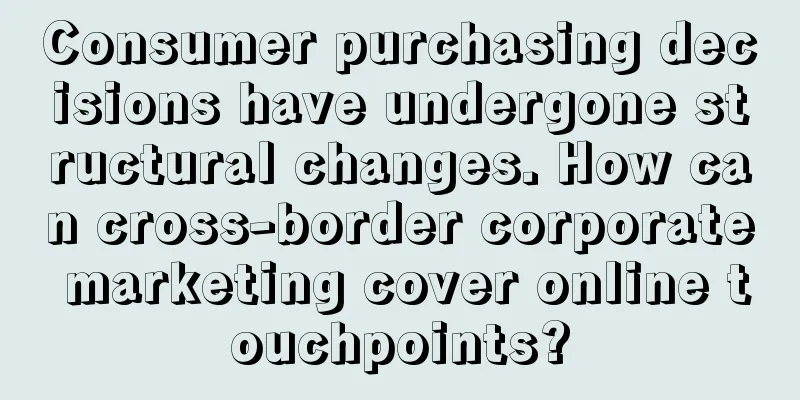Consumer purchasing decisions have undergone structural changes. How can cross-border corporate marketing cover online touchpoints?

|
The global epidemic has entered its third year, and its dialectical impact on the global economy has become increasingly obvious: it has changed the consumption logic of consumers in the past, and the scale of online consumption has surged. Under the influence of the convenience of online consumption, some consumers have adapted to online consumption , while some consumers cannot give up the service experience of offline consumption . However, from the general changes in consumption habits, it can be seen that consumers' purchasing paths have changed accordingly.
Therefore, from the brand's standpoint, if they want to establish deeper communication with consumers through marketing, they also need certain changes and considerations. Under this premise, whether it is for cross-border e-commerce sellers on large platforms such as Amazon and Walmart, or DTC brands that expand the independent website model , currently improving online consumer stickiness and effectively implementing localized marketing are the key to coping with the new market environment.
On this road, how can we truly be consumer-centric? We must not only re-understand the consumer purchase path from the user's perspective, but also upgrade the observation logic from the marketing perspective .
Non-linear changes in consumption paths: Focusing on consumers and deploying full-link marketing
Generally speaking, we divide the broad purchase path of consumers into five stages: exposure to information, extensive search, investigation and research, interest generation, and sharing experience after purchase . Traditional marketing practices understand this process as a chain-type, step-by-step, and sequential process.
Therefore, what brands need to do is basically the same: expand exposure and complete traffic generation when consumers are exposed to information and conduct extensive searches; let traditional digital advertising information ferment in consumer surveys, gradually generate interest in the brand or product, and ultimately reach a purchasing decision.
Obviously, this way of understanding the consumption path is no longer in line with the objective reality of current consumption behavior, and it also ignores the "ecological" nature of online consumption. In the new media communication environment, the complete consumer purchase path is not a chain-type, but a cycle-type. The various stages of the purchase process are intertwined at any time and constantly evolve, ultimately increasing the repurchase rate.
If marketing activities are still carried out based on the traditional understanding of consumption paths, two problems that brands tend to overlook will arise: first, the brand only plays a role in the exposure and traffic stage in the consumer purchase path; second, the brand is unable to transform the post-purchase sharing experience into effective high-quality UGC content. Both of these points are obstacles to promoting the path cycle.
In the chain-type consumption path, the purchase intention of online consumption is concentrated at the back end of the path; while in the circular consumption path, consumers may have the purchase intention at every stage, which also requires overseas companies to arrange appropriate marketing methods at every key node and establish purchase channels. This is also a significant difference between the two paths. In addition, in the circular consumption path, the sharing experience of consumers after purchase directly affects the information that consumers can access for the first time, becoming effective UGC content.
The nonlinear changes in consumers' purchase paths make it possible for consumers to make purchases at every stage of the entire consumption path, bringing challenges and opportunities to brands in full-link marketing. At this time, the brand's large-scale marketing plan layout for full-link marketing and diversified partner marketing methods will have the effect of amplifying marketing effectiveness.
However, how to manage large-scale partner marketing projects and analyze marketing data is difficult. This requires the technical support of a partner marketing management SaaS platform such as impact.com, which allows brands to easily deploy full-link marketing.
Make full use of marketing attribution to find the key marketing nodes that influence consumer decisions
Cross-border e-commerce has developed into a mature market. In the circular consumption path, brands need to continuously optimize their partners' marketing projects based on marketing data at each stage. The premise of this optimization is marketing attribution, that is, systematically attributing marketing effects based on different dimensions such as marketing, product operations, and user operations, so as to determine the following two issues:
1. At which stage of brand awareness do most brand consumers focus? 2. To which cognitive stage does the brand need to guide consumers?
In short, it means conducting customer journey analysis in multiple dimensions.
In the three stages of traffic generation, conversion and repurchase, companies can observe which user behaviors consumers prefer and which marketing actions they respond to more strongly through marketing attribution, and then adjust marketing plans and budgets accordingly. In actual operations, what can really help brands optimize their partners' marketing projects is real, comprehensive and fine-grained marketing data from all stages of the consumer purchase path.
By analyzing marketing data and using appropriate marketing attribution models, companies can also evaluate consumer experience throughout the entire consumption path, thereby improving it and finding new growth points. In a cyclical consumption path, marketing is a whole. As the purchasing paths of consumers in different industries change, using different marketing forms to reach consumers with brand or product information can make marketing content less annoying and more effective.
Starting from the actual needs of cross-border e-commerce in the post-epidemic era, we can further understand the changes in consumer purchase paths and optimize the attribution capabilities of marketing methods, so that corporate marketers can have a deeper understanding and cognition of effective ROI. Impact.com helps companies carry out large-scale partner marketing projects, allowing brand content to penetrate the decision-making path of target consumer groups, thereby achieving efficient conversion. |
<<: Deploy potential platforms, Shenzhen's top sellers have more than 10,000 orders per month
>>: Loan 5 million from Amazon without paying it back? Beware of scams!
Recommend
Anker's trump card can no longer be hidden
Returning to the energy storage track in 2022, An...
Sales surge 300 times, production capacity increased and recruitment expanded, SHEIN helps cross-border sellers prepare for the peak season
Some cross-border sellers who mainly sell oversea...
22 yuan/kg for the ransom? The owner refuses to pay! The latest plan is a big deal again
On April 16, the Fengbang Logistics cargo detenti...
What is AMZAlert
AMZAlert provides 24-hour monitoring with detaile...
Jiangsu Dama special dividend of 70 million
In 2024, the performance increased by more than 4...
What is Shanghai Hongshan International Logistics Co., Ltd.? Shanghai Hongshan International Logistics Co., Ltd. Review, Features
Shanghai Hongshan International Logistics Co., Ltd...
Tik Tok has nearly 300,000 likes, and a common product has become a hit on Amazon
The social e-commerce market is becoming increasi...
What is TrafficWiser? TrafficWiser Review, Features
TrafficWiser is a one-click query platform based ...
The search volume increased by 2512%, and this year's back-to-school season's best-selling product turned out to be this
The back-to-school season from July to September ...
Amazon has just released a new feature
Recently, there have been frequent incidents of p...
Losses of over 30 million in half a year! The company is in decline after selling its products in bulk
The products are selling well but are still stuck...
An anti-Coupang alliance is forming! South Korea's Naver and E-Mart discuss equity swap
As Coupang once again raised the price range of i...
Sold out! This Southeast Asian country is in lockdown again, and 550,000 pieces of this product were sold in 5 days
It is reported that in view of the fact that the ...
What is Pronto? Pronto Review, Features
Pronto is a comparison shopping site owned by Bar...
Its subsidiary owes sellers 900 million yuan, and the parent company has set its sights on Wish!
Recently, the fact that two well-known Korean e-c...









